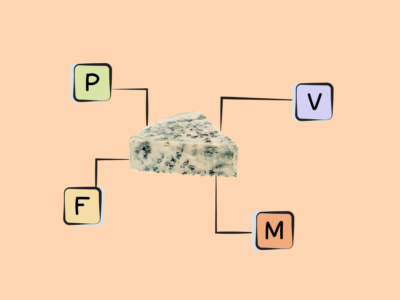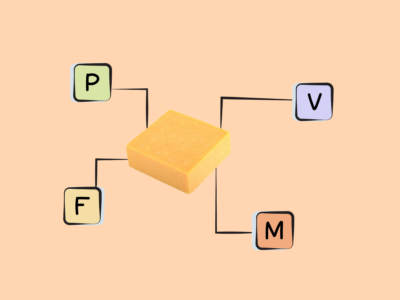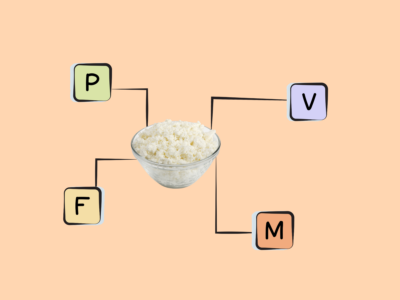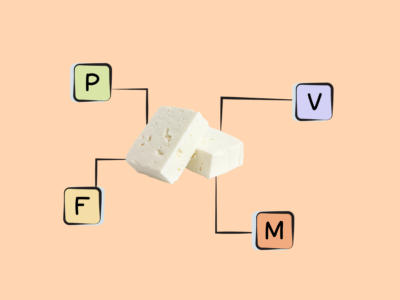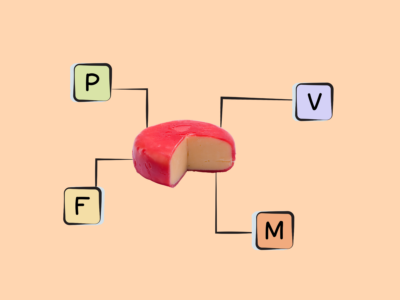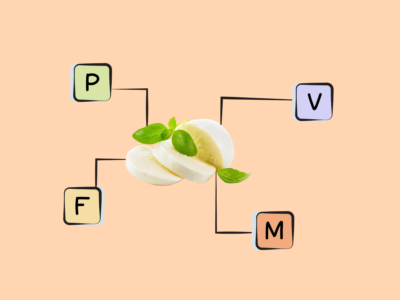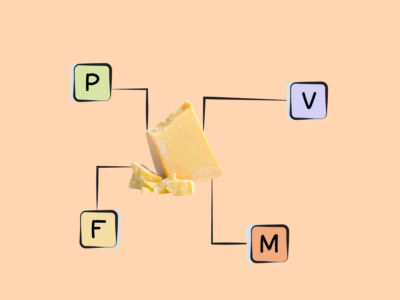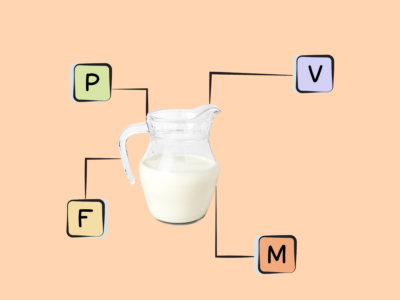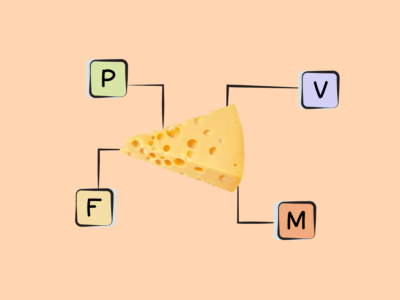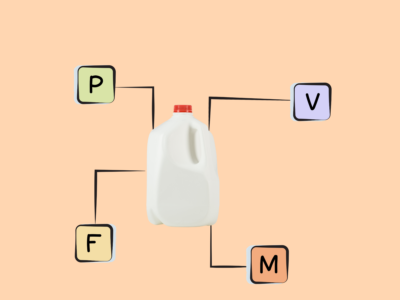Table of Contents[Hide][Show]
Health Benefits of Dairy Products
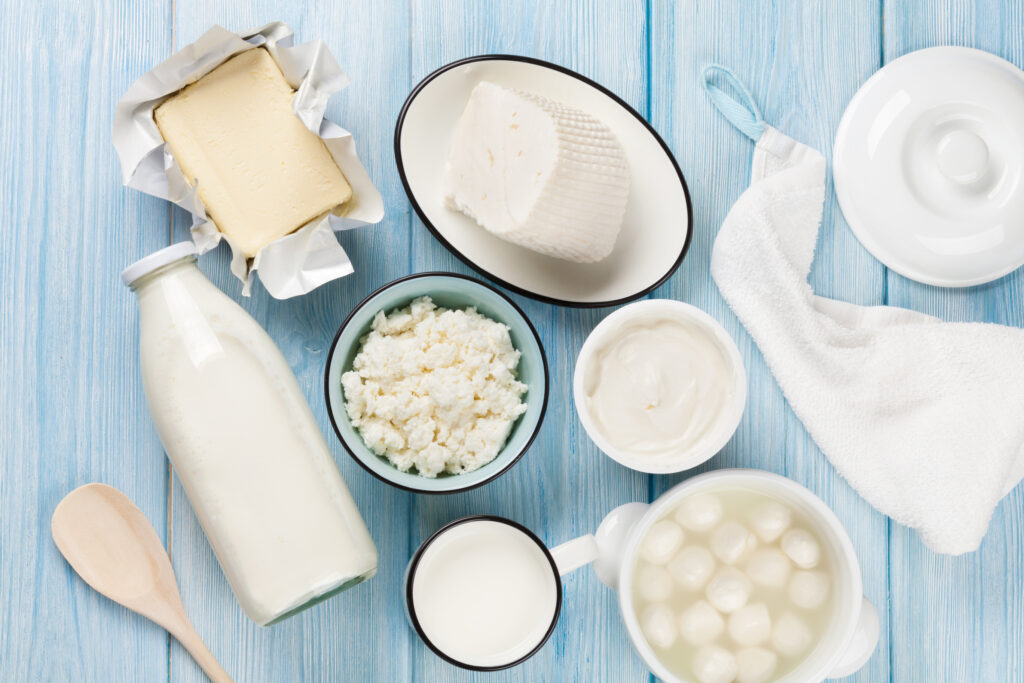
Dairy products are not only rich in calcium and protein, it’s also an excellent source of fat-soluble vitamins, a range of other micronutrients, and conjugated linoleic acid (CLA)—a naturally occurring “good” trans fat created when ruminant animals consume plant foods convert linoleic acid (an omega-6 fat) into stearic acid (a saturated fat) via bacteria in their rumens. Beyond that, the nutritional profile of dairy differs depending on the type of dairy product and the animal milk it comes from. Hard cheeses in general tend to be a good source of vitamin K2; sheep milk products are higher in vitamin B12, magnesium, folate, riboflavin, selenium, and vitamin C (not present at all in cow’s milk); and goat milk products are higher in vitamin A, vitamin B6, phosphorus, and copper.
A 2021 meta-analysis of 55 prospective cohort studies found that dairy consumption in general was associated with a 10% lower risk of stroke, a 4% lower risk of coronary heart disease, and a 9% reduced risk of hypertension (high blood pressure). A 2016 meta-analysis of 29 cohort studies showed that cheese reduced cardiovascular disease risk, and fermented dairy reduced total mortality risk, albeit by a very modest amount (2% per 20 gram serving of fermented dairy or 10 gram serving of cheese). Importantly, a 2017 meta-analysis revealed a U-shaped dose response curve for dairy products, with intake up to about 400 grams daily modestly reducing all-cause mortality (again, only about a 2% effect), but higher consumption levels no longer being beneficial—intake greater than 1000 grams per day was associated with a 15% increased risk of total mortality.
A2 dairy—especially full-fat dairy from grass-fed animals—confers some unique benefits for our health. This type of milk differs from A1 milk by a single amino acid swap within the β-casein protein (A1 dairy has histidine at position 67 of the amino acid chain, while A2 dairy has proline there). This one tiny difference means that unlike A1 dairy, A2 dairy can’t be broken down into β-casomorphin-7 (BCM-7), a peptide product that can cause symptoms resembling lactose intolerance, may contribute to atherosclerosis and ischemic heart disease, and may potentially even trigger type 1 diabetes. These different milk types are believed to have originated from a mutation in cattle dating back between 5000 and 10,000 years ago, which was subsequently made widespread through cattle breeding. A1-producing Holsteins are the most common dairy cows in the US, Australia, and Northern Europe, and therefore most commercially available dairy products in these areas are made from A1 milk. In contrast, A2 dairy that comes from sheep, goats, camels, buffalo, yaks, reindeer, horses, and some breeds of cow (including Guernsey, Jersey, African, and Asian). A2 dairy has been shown to result in less bloating and GI distress than A1 dairy. Additional research has shown that consuming full-fat and fermented dairy products can protect against metabolic syndrome, type 2 diabetes (fermented dairy only), and cardiovascular disease.
Nutrivore Is a Game-Changer—This FREE Guide Shows You Why
Sign up for the free Nutrivore Newsletter, your weekly, science-backed guide to improving health through nutrient-rich foods — without dieting harder —and get the Beginner’s Guide to Nutrivore delivered straight to your inbox!

Examples of Dairy Products
- butter
- buttermilk
- butter oil
- cheese
- cottage cheese
- cream
- curds
- ghee
- heavy cream
- ice cream
- kefir
- milk
- sour cream
- whipping cream
- yogurt
Nutrients in Dairy Products

Checklists and Planning Tools
Make Nutrivore simple and easy with these handy-dandy planning tools and checklists.
Help me to keep building Nutrivore.com

I’m working on writing more awesome articles on this topic to be featured right here on this webpage. If you’re enjoying the content my team and I have created thus far and would like to see more, you can support our efforts to keep building out this site by joining the Nutrivore community on Patreon!
Plus every month, you’ll gain exclusive and early access to a variety of resources, including a weekly video podcast, a new e-book in a series, nutrient fun factsheet, and more! Sign up now and also get 5 free Nutrivore guides as a welcome gift! Win-win-win!
Citations
Expand to see all scientific references for this article.
An, C., T. Kuda, T. Yazaki, et al. 2014. “Caecal fermentation, putrefaction and microbiotas in rats fed milk casein, soy protein or fish meal”. Applied Microbiology and Biotechnology. 98:2779–2787. doi:10.1007/s00253-013-5271-5.
Belury, M.A. 2002. “Inhibition of carcinogenesis by conjugated linoleic acid: potential mechanisms of action.” Journal of Nutrition. 132(10):2995-2998. doi:10.1093/jn/131.10.2995.
Castro-Webb, N., E.A. Ruiz-Narváez, and H. Campos. 2012. “Cross-sectional study of conjugated linoleic acid in adipose tissue and risk of diabetes.” American Journal of Clinical Nutrition. 96(1):175-81. doi:10.3945/ajcn.111.011858.
Chaplin, A., P. Parra, F. Serra, A. Palou. 2015. “Conjugated Linoleic Acid Supplementation under a High-Fat Diet Modulates Stomach Protein Expression and Intestinal Microbiota in Adult Mice.” PLoS One. 10(4):e0125091. doi:10.1371/journal.pone.0125091.
Chen Z, Ahmed M, Ha V, Jefferson K, Malik V, Ribeiro PAB, Zuchinali P, Drouin-Chartier JP. Dairy Product Consumption and Cardiovascular Health: a Systematic Review and Meta-Analysis of Prospective Cohort Studies. Adv Nutr. 2021 Sep 22;13(2):439–54. doi: 10.1093/advances/nmab118.
Churruca, I., A. Fernández-Quintela, and M.P. Portillo. 2009. “Conjugated linoleic acid isomers: differences in metabolism and biological effects.” Biofactors. 35(1):105-11. doi:10.1002/biof.13.
Coakley, M., M.C. Johnson, E. McGrath, et al. 2006. “Intestinal bifidobacteria that produce trans-9, trans-11 conjugated linoleic acid: a fatty acid with antiproliferative activity against human colon SW480 and HT-29 cancer cells.” Nutrition and Cancer. 56(1):95‐102. doi:10.1207/s15327914nc5601_13.
Coakley, M., M.C. Johnson, E. McGrath, et al. 2006. “Intestinal bifidobacteria that produce trans-9, trans-11 conjugated linoleic acid: a fatty acid with antiproliferative activity against human colon SW480 and HT-29 cancer cells.” Nutrition and Cancer. 56(1):95‐102. doi:10.1207/s15327914nc5601_13.
Coakley, M., R. Ross, M. Nordgren, G. Fitzgerald, R. Devery, and C. Stanton. 2003. “Conjugated linoleic acid biosynthesis by human‐derived Bifidobacterium species.” Journal of Applied Microbiology. 94:138-145. doi:10.1046/j.1365-2672.2003.01814.x.
Dhiman, T.R., G.R. Anand, L.D. Satter, and M.W. Pariza. 1999. “Conjugated linoleic acid content of milk from cows fed different diets.” Journal of Dairy Science. 82(10):2146‐2156. doi:10.3168/jds.S0022-0302(99)75458-5.
Evans, M., X. Lin, J. Odle, and M. McIntosh. 2002 “Trans-10, cis-12 conjugated linoleic acid increases fatty acid oxidation in 3T3-L1 preadipocytes.” Journal of Nutrition.132(3):450-5. doi:10.1093/jn/132.3.450.
Gorissen, L., F. Leroy, L. De Vuyst, S. De Smet, K. Raes. 2015. “Bacterial production of conjugated linoleic and linolenic Acid in foods: a technological challenge.” Critical Reviews in Food Science and Nutrition. 55(11):1561-74. doi:10.1080/10408398.2012.706243.
Gorissen, L., L. De Vuyst, K. Raes, S. De Smet, and F. Leroy. 2012. “Conjugated linoleic and linolenic acid production kinetics by bifidobacteria differ among strains.” International Journal of Food Microbiology. 155(3):234‐240. doi:10.1016/j.ijfoodmicro.2012.02.012
Guo J, Astrup A, Lovegrove JA, Gijsbers L, Givens DI, Soedamah-Muthu SS. Milk and dairy consumption and risk of cardiovascular diseases and all-cause mortality: dose-response meta-analysis of prospective cohort studies. Eur J Epidemiol. 2017 Apr;32(4):269-287. doi: 10.1007/s10654-017-0243-1.
Heinze, V.M., and A.B. Actis. 2012. “Dietary conjugated linoleic acid and long-chain n-3 fatty acids in mammary and prostate cancer protection: a review.” International Journal of Food Science and Nutrition. 63(1):66-78. doi:10.3109/09637486.2011.598849.
Ho, S., K. Woodford, S. Kukuljan, and S. Pal. 2014. “Comparative effects of A1 versus A2 beta-casein on gastrointestinal measures: a blinded randomised cross-over pilot study.”
Ijaz, M.U., M.I. Ahmed, X. Zou, et al. 2018. “Beef, Casein, and Soy Proteins Differentially Affect Lipid Metabolism, Triglycerides Accumulation and Gut Microbiota of High-Fat Diet-Fed C57BL/6J Mice.” Frontiers of Microbiology. 9:2200. doi:10.3389/fmicb.2018.02200.
Ip, M.M., P.A. Masso-Welch, and C. Ip. 2003. “Prevention of mammary cancer with conjugated linoleic acid: role of the stroma and the epithelium.” Journal of Mammary Gland Biology and Neoplasia. 8(1):103-118. doi:10.1023/a:1025739506536.
Jianqin, S., X. Leiming, X. Lu, G.W. Yelland, J. Ni, and A.J. Clarke. 2016. “Effects of milk containing only A2 beta casein versus milk containing both A1 and A2 beta casein proteins on gastrointestinal physiology, symptoms of discomfort, and cognitive behavior of people with self-reported intolerance to traditional cows’ milk.” Nutrition Journal. 15:35. doi:10.1186/s12937-016-0147-z.
Kennedy, A., K. Martinez, S. Schmidt, S. Mandrup, K. LaPoint, and M. McIntosh. 2010. “Antiobesity mechanisms of action of conjugated linoleic acid.” The Journal of Nutritional Biochemistry. 21(3):171-9. doi:10.1016/j.jnutbio.2009.08.003.
Kim, K.J., J. Lee, Y. Park, and S.H. Lee. 2015. “ATF3 Mediates Anti-Cancer Activity of Trans-10, cis-12-Conjugated Linoleic Acid in Human Colon Cancer Cells.” Biomolecules & Therapeutics. 23(2):134-40. doi:10.4062/biomolther.2014.107.
Kishino, S., J. Ogawa, Y. Omura, Y. et al. 2002. “Conjugated linoleic acid production from linoleic acid by lactic acid bacteria.” Journal of the American Oil Chemists’ Society. 79:159–163 (2002). doi:10.1007/s11746-002-0451-4.
Laugesen, M., and R. Elliott. 2003. “Ischaemic heart disease, Type 1 diabetes, and cow milk A1 beta-casein.” New Zealand Medical Journal. 116(1168):U295.
Marques, T.M., R. Wall, O. O’Sullivan, et al. 2015. “Dietary trans-10, cis-12-conjugated linoleic acid alters fatty acid metabolism and microbiota composition in mice.” British Journal of Nutrition. 113(5):728‐738. doi:10.1017/S0007114514004206.
Marshall, K. 2004. “Therapeutic applications of whey protein.” Alternative Medicine Review. 9(2):136-156.
Miner, J.L., C.A. Cederberg, M.K. Nielsen, X. Chen, and C.A. Baile. 2011. “Conjugated linoleic acid (CLA), body fat, and apoptosis.” Obesity Research. 9(2):129-34. doi:10.1038/oby.2001.16.
Moloney, F., S. Toomey, E. Noone, et al. 2007. “Antidiabetic effects of cis-9, trans-11-conjugated linoleic acid may be mediated via anti-inflammatory effects in white adipose tissue.” Diabetes. 56(3):574-82. doi:10.2337/db06-0384.
Raimondi, S., A. Amaretti, A. Leonardi, A. Quartieri, C. Gozzoli, and M. Rossi. 2016. “Conjugated Linoleic Acid Production by Bifidobacteria: Screening, Kinetic, and Composition.” Biomed Research International. 2016(8654317). doi:10.1155/2016/8654317.
Schwingshackl L, Schwedhelm C, Hoffmann G, Lampousi AM, Knüppel S, Iqbal K, Bechthold A, Schlesinger S, Boeing H. Food groups and risk of all-cause mortality: a systematic review and meta-analysis of prospective studies. Am J Clin Nutr. 2017 Jun;105(6):1462-1473. doi: 10.3945/ajcn.117.153148.
Smit, L.A., A. Baylin, H. Campos. 2010. “Conjugated linoleic acid in adipose tissue and risk of myocardial infarction.” American Journal of Clinical Nutrition. 92(1):34-40. doi:10.3945/ajcn.2010.29524.
Sprong, R.C., A.J. Schonewille, and R. Meer. 2010. “Dietary cheese whey protein protects rats against mild dextran sulfate sodium-induced colitis: Role of mucin and microbiota.” Journal of Dairy Science. 93:1364-71. 10.3168/jds.2009-2397.
Tailford, K.A., C.L. Berry, A.C. Thomas, and J.H. Campbell. 2003. “A casein variant in cow’s milk is atherogenic.” Atherosclerosis. 170(1):13-19. doi:10.1016/s0021-9150(03)00131-x.
Ul Haq, M.R., R. Kapila, R. Sharma, V. Saliganti, and S. Kapila. 2014. “Comparative evaluation of cow β-casein variants (A1/A2) consumption on Th2-mediated inflammatory response in mouse gut.” European Journal of Nutrition. 53(4):1039-1049. doi:10.1007/s00394-013-0606-7.
Wahle, K.W., S.D. Heys, and D. Rotondo. 2004. “Conjugated linoleic acids: are they beneficial or detrimental to health?” Progress in Lipid Research. 43(6):553-87. doi:10.1016/j.plipres.2004.08.002.
West, D.B., F.Y. Blohm, A.A. Truett, and J.P. DeLany. 2000. “Conjugated linoleic acid persistently increases total energy expenditure in AKR/J mice without increasing uncoupling protein gene expression.” Journal of Nutrition. 130(10):2471-7. doi:10.1093/jn/130.10.2471.
Whigham, L.D., A.C. Watras, and D.A. Schoeller. 2007. “Efficacy of conjugated linoleic acid for reducing fat mass: a meta-analysis in humans.” American Journal of Clinical Nutrition. 85(5):1203-11. doi:10.1093/ajcn/85.5.1203.



